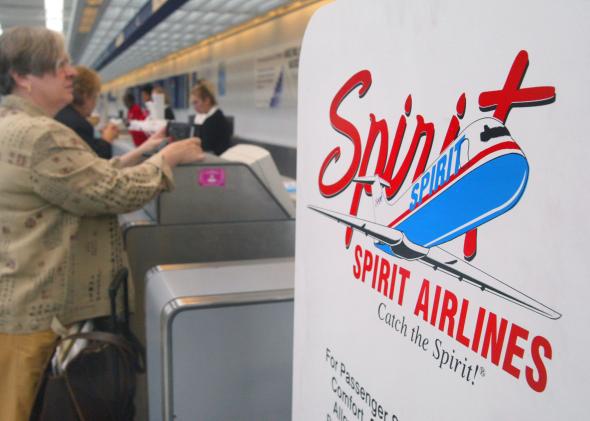Reclining seats on planes are all the rage these days—literally. People are either enraged at the jerks who try to prevent fellow airline riders from reclining their seats, or enraged that airlines were audacious enough to introduce reclining seats in the first place. The question—to recline or not to recline—has been debated furiously ever since a United Airlines flight from Newark to Denver was forced to divert to Chicago in late August after two passengers on board got into a fight over legroom. Over the next several days, two additional flights—one from American Airlines and one from Delta—were forced to do the same after similar legroom squabbles broke out.
Recline rage might be sweeping the skies, but two U.S. airlines are notably immune. On both Spirit Airlines and Allegiant Air, there are no reclining seats to be found. Allegiant was the first to convert to stationary seats in 2006; Spirit followed in 2009. The business reasons behind the decision are straightforward. First, nonreclining seats are simpler to construct and far less likely to break and be taken out of service, leading to costly repairs and lost revenues on that seat. Second, taking the recline mechanism out of seats makes them lighter and allows the plane to carry additional weight in passengers and spend less on fuel. Allegiant estimates that eliminating reclining seats saves it $3.5 million a year on maintenance and conserves 110,000 gallons of fuel (or about $350,000 worth, depending on prices).
Personal preference has also factored in to the decision. “I don’t like reclining seats,” says Andrew Levy, president and chief operating officer of Allegiant Travel and Allegiant Air. He recalls traveling in Europe on Ryanair about 10 years ago on a flight that had smaller seat sizes—or a tighter “pitch,” as people in the industry term it—but no recline mechanism. “I sat in the seat and realized that yes, you might have a little less pitch, but what really affects the space is when the seat in front of you reclines. That’s when it kind of just hit me that this makes perfect sense, and so we decided to build our own seats, design our own seats, and start putting them in our aircrafts.”
Paul Berry, a spokesman for Spirit Airlines, said the company weighed similar business considerations—gas and maintenance—in its decision to cut reclining seats. And after five years of flying like that, he adds that customers don’t seem to mind. “Almost every poll we’ve done or taken or seen shows that people would prefer not to have reclining seats if they had the choice,” Berry says. Indeed, an October 2013 report from Skyscanner found that 91 percent of 1,000 people surveyed said short-haul flights should either ban or set time limits on reclining seats. Levy also says the nonreclining seats have been a “non-issue” for Allegiant’s customers.
If people are so overwhelmingly in favor of banning reclining seats, why do the majority of planes still use them? Because they always have. “I think reclining seats have just been part of airlines for a long time,” says Berry. “And meals were a part of airlines for a long time and when airlines started taking meals off planes consumers complained about it, but then they got used to it. When we started charging for checked bags people complained, but then they got used to it.”
For now, it’s unclear if other major U.S. airlines will follow Allegiant’s and Spirit’s lead and ditch their own reclining mechanisms. So long as they don’t, Berry and Levy are in agreement on one last point: If an airline sells a seat that reclines, you should be able to recline it.
